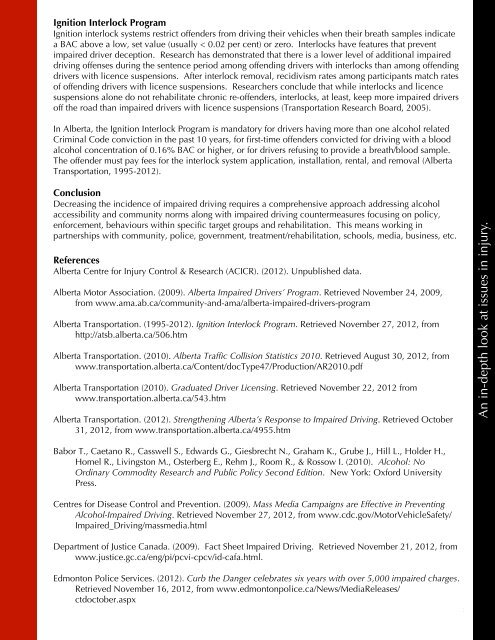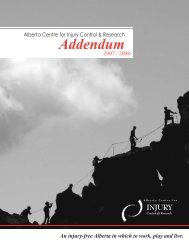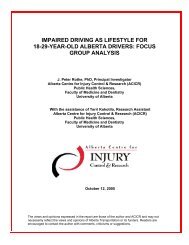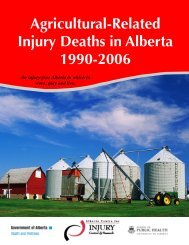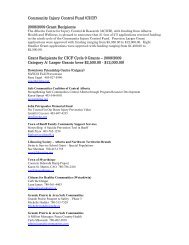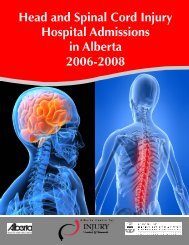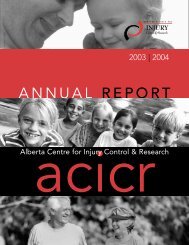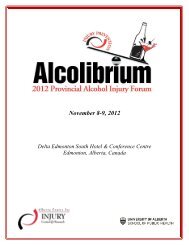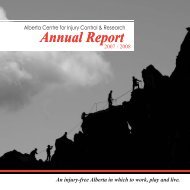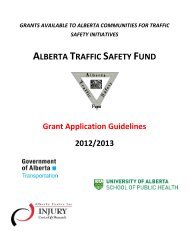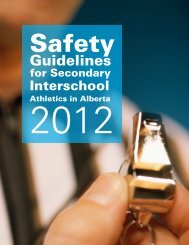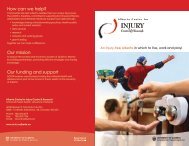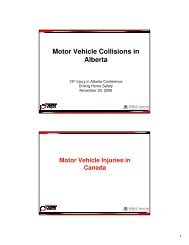Impaired Driving - Alberta Centre for Injury Control & Research
Impaired Driving - Alberta Centre for Injury Control & Research
Impaired Driving - Alberta Centre for Injury Control & Research
You also want an ePaper? Increase the reach of your titles
YUMPU automatically turns print PDFs into web optimized ePapers that Google loves.
Ignition Interlock Program<br />
Ignition interlock systems restrict offenders from driving their vehicles when their breath samples indicate<br />
a BAC above a low, set value (usually < 0.02 per cent) or zero. Interlocks have features that prevent<br />
impaired driver deception. <strong>Research</strong> has demonstrated that there is a lower level of additional impaired<br />
driving offenses during the sentence period among offending drivers with interlocks than among offending<br />
drivers with licence suspensions. After interlock removal, recidivism rates among participants match rates<br />
of offending drivers with licence suspensions. <strong>Research</strong>ers conclude that while interlocks and licence<br />
suspensions alone do not rehabilitate chronic re-offenders, interlocks, at least, keep more impaired drivers<br />
off the road than impaired drivers with licence suspensions (Transportation <strong>Research</strong> Board, 2005).<br />
In <strong>Alberta</strong>, the Ignition Interlock Program is mandatory <strong>for</strong> drivers having more than one alcohol related<br />
Criminal Code conviction in the past 10 years, <strong>for</strong> first-time offenders convicted <strong>for</strong> driving with a blood<br />
alcohol concentration of 0.16% BAC or higher, or <strong>for</strong> drivers refusing to provide a breath/blood sample.<br />
The offender must pay fees <strong>for</strong> the interlock system application, installation, rental, and removal (<strong>Alberta</strong><br />
Transportation, 1995-2012).<br />
Conclusion<br />
Decreasing the incidence of impaired driving requires a comprehensive approach addressing alcohol<br />
accessibility and community norms along with impaired driving countermeasures focusing on policy,<br />
en<strong>for</strong>cement, behaviours within specific target groups and rehabilitation. This means working in<br />
partnerships with community, police, government, treatment/rehabilitation, schools, media, business, etc.<br />
References<br />
<strong>Alberta</strong> <strong>Centre</strong> <strong>for</strong> <strong>Injury</strong> <strong>Control</strong> & <strong>Research</strong> (ACICR). (2012). Unpublished data.<br />
<strong>Alberta</strong> Motor Association. (2009). <strong>Alberta</strong> <strong>Impaired</strong> Drivers’ Program. Retrieved November 24, 2009,<br />
from www.ama.ab.ca/community-and-ama/alberta-impaired-drivers-program<br />
<strong>Alberta</strong> Transportation. (1995-2012). Ignition Interlock Program. Retrieved November 27, 2012, from<br />
http://atsb.alberta.ca/506.htm<br />
<strong>Alberta</strong> Transportation. (2010). <strong>Alberta</strong> Traffic Collision Statistics 2010. Retrieved August 30, 2012, from<br />
www.transportation.alberta.ca/Content/docType47/Production/AR2010.pdf<br />
<strong>Alberta</strong> Transportation (2010). Graduated Driver Licensing. Retrieved November 22, 2012 from<br />
www.transportation.alberta.ca/543.htm<br />
<strong>Alberta</strong> Transportation. (2012). Strengthening <strong>Alberta</strong>’s Response to <strong>Impaired</strong> <strong>Driving</strong>. Retrieved October<br />
31, 2012, from www.transportation.alberta.ca/4955.htm<br />
An in-depth look at issues in injury.<br />
Babor T., Caetano R., Casswell S., Edwards G., Giesbrecht N., Graham K., Grube J., Hill L., Holder H.,<br />
Homel R., Livingston M., Osterberg E., Rehm J., Room R., & Rossow I. (2010). Alcohol: No<br />
Ordinary Commodity <strong>Research</strong> and Public Policy Second Edition. New York: Ox<strong>for</strong>d University<br />
Press.<br />
<strong>Centre</strong>s <strong>for</strong> Disease <strong>Control</strong> and Prevention. (2009). Mass Media Campaigns are Effective in Preventing<br />
Alcohol-<strong>Impaired</strong> <strong>Driving</strong>. Retrieved November 27, 2012, from www.cdc.gov/MotorVehicleSafety/<br />
<strong>Impaired</strong>_<strong>Driving</strong>/massmedia.html<br />
Department of Justice Canada. (2009). Fact Sheet <strong>Impaired</strong> <strong>Driving</strong>. Retrieved November 21, 2012, from<br />
www.justice.gc.ca/eng/pi/pcvi-cpcv/id-cafa.html.<br />
Edmonton Police Services. (2012). Curb the Danger celebrates six years with over 5,000 impaired charges.<br />
Retrieved November 16, 2012, from www.edmontonpolice.ca/News/MediaReleases/<br />
ctdoctober.aspx<br />
4


